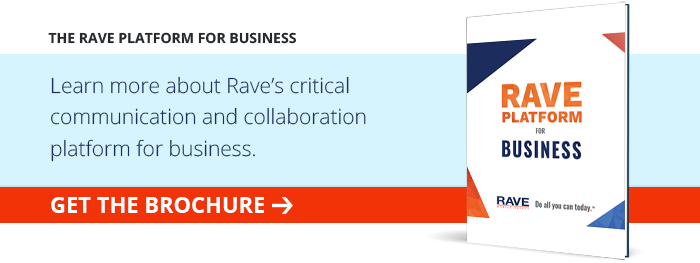Favoriser un retour en douceur sur le lieu de travail grâce aux solutions de sécurité de Rave Business
There is still a lot of uncertainty about when many businesses will welcome employees back to the workplace. While some businesses appear to be gearing up for a “return to the new normal” at the start of the fall school term, others are reticent to commit to a return-to-work date due to concerns about the health and safety of employees and operational stability.
Decisions about when to welcome employees back to the workplace seem to be driven by the location of the business, the nature of its operations, and individual employers’ preferences.
- For example, businesses in California may be more reluctant to expose employees to the risk of infection following the passage of SB 1159.
- Finance company chiefs have called remote working “an aberration” and are reportedly further ahead with return-to-work plans than tech companies.
- Google – a tech company with its headquarters in California – has said it expects employees to return to the workplace on 1st September under a hybrid model.
Other factors such as further state COVID-19 worker protections, OSHA’s COVID-19 Emergency Temporary Standard, and the faltering speed at which employees are getting vaccinated, are also influencing businesses’ decisions about returning to the workplace full-time, adopting a hybrid model, or maintaining work-from-home operations until the picture becomes clearer.
In addition to regulatory obstacles and concerns about employee welfare, the risk exists of further lockdowns and stay-at-home orders if the accelerated relaxation of COVID-19 mitigation measures results in another wave. For many businesses, opening up the workplace and then closing it down again may have a significant impact on the business’s operational stability.
It’s More a Question of How, Rather Than When
While most employees would prefer to be in the workplace at least some of the time, concerns exist about the safety of being in a confined workspace with potentially infected colleagues (whether vaccinated or not), the safety of the commute to work, and the ability to transition from working remotely to working in-person while preserving newly-established work/life balances.
Although businesses can take measures to address workspace safety, managing the commute to work and personal work/life balances are usually out of their hands. Nonetheless, businesses need to be aware of these concerns so they can offer support wherever possible (for example by organizing split shifts and mental health resources) to alleviate return-to-work concerns.
Indeed, there are likely to be more concerns than those listed above, and businesses need to feel the pulse of workforce sentiment early and often – ideally by advising employees of new workplace protocols before they return to in-person working, and then by conducting regular pulse surveys to identify concerns that may lead to issues with staff well-being, productivity, and profitability.
Supporting a Smooth Return to the Workplace
One of the most effective ways to advise employees of new workplace protocols and conduct pulse surveys is via an employee safety app; for although protocols and surveys could be sent to employees by email, research suggests only a third of business emails are ever read by employees – implying that important safety measures being introduced to the workplace could be overlooked.
An employee safety app enables businesses to send protocols and surveys via push notifications, which has the advantage of separating “return-to-work” communications from other business emails. Workplace protocols can also be uploaded to the app so employees always have them at their fingertips whether they are at work, at home, or travelling between the two.
The immediacy of push notifications means that employee safety apps can be used to effectively advise employees of on-premises infections, workplace closures, and alternate working arrangements; while the anonymous tip texting capabilities of the app empower employees to alert managers to colleagues who are displaying symptoms of COVID-19, failing to comply with workplace safety protocols, or failing to cope with the “return to the new normal”.
Rave Mobile Safety’s Return to Work Communication Solutions
Rave Mobile Safety’s communication solutions help businesses address every return to work concern they are likely to encounter. The Rave platform can be configured to operate as an emergency alert system, a collaboration tool, and a critical incident management solution. Additional solutions such as mobile panic buttons and employee safety apps enhance the platform’s capabilities by enabling the automation of emergency response for faster business recovery.
With regards to supporting a smooth return to the workplace, in addition to providing a dedicated channel for return-to-work communications, the Rave platform can help overcome potential issues such as presenteeism, COVID stigma, and inconsistencies between how COVID mitigation strategies are enforced in different offices. You can find out more about Rave Mobile Safety’s return to work communication solutions on this page, or by contacting us and speaking with one of our team.





